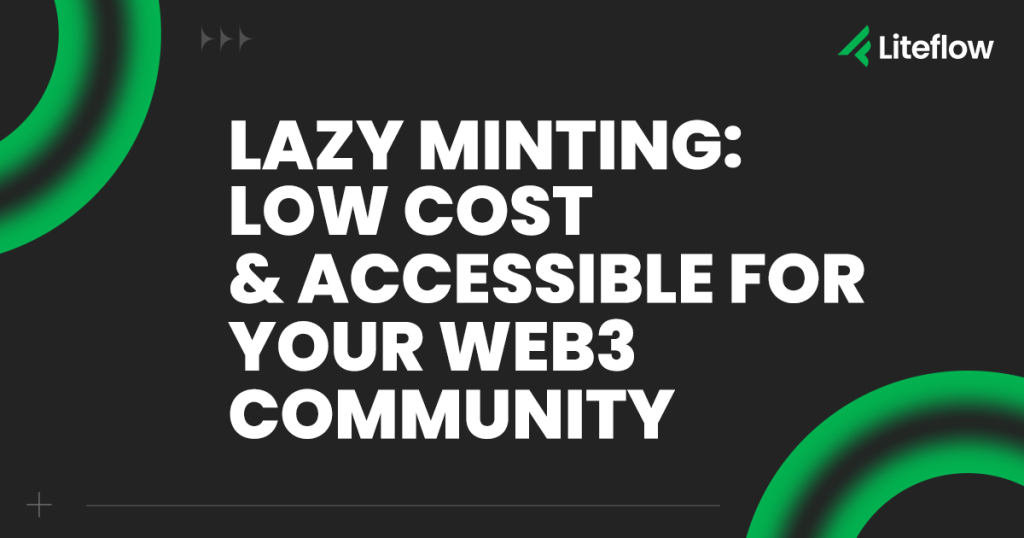Lazy Minting: Low Cost & Accessible for Your Web3 Community

There are still many barriers to entry for creators exploring the NFT space. As Web3 companies look to onboard users en masse, a few advanced options exist that can cut the costs of entering the world of NFTs, making products more accessible for new users. Lazy minting is one of these options, optimizing the costs of the minting process when compared to traditional methods. The costs associated with an average NFT mint can be high, as writing, storing and transacting on the blockchain requires a fee (commonly referred to as gas). Lazy minting provides a viable solution.
What is NFT Minting?
Minting an NFT is the process of turning a digital file into a non-fungible asset living on a blockchain, assigning it a unique token identifier. This process requires a smart contract to facilitate the creation, storage and transfer of this asset on a distributed ledger that is impossible to modify or delete. The process of minting an NFT varies depending on the platform, but many marketplaces aim to simplify it for users. Despite the platform of choice, minting an NFT requires a gas fee to write information to the blockchain network. This gas fee can be delayed thanks to lazy minting, helping alleviate the burden on creators.
What is Lazy Minting?
Lazy minting postpones the costs of minting until the NFT is sold to its first buyer. This is achieved by coupling the minting gas fees with the same purchase transaction executed by the buyer. This ensures that the creator of the NFT never pays to mint the asset by covering minting costs with a percentage of the purchase price.
Without getting too in the weeds, lazy minting replaces the direct contract function that creates an NFT with a cryptographic signature of data using their private key. The signed data represents a kind of ticket that holds all relevant information that will go into the NFT. The ticket can then be redeemed for the NFT, with the creator’s signature authorizing the NFT described within the ticket. Assuming the signature is authentic, a buyer can redeem the ticket and a new token is minted and sent to the buyer.
The Benefits of Lazy Minting
Lower Costs
The most prominent blockchain network being used by NFT companies is Ethereum. When the Ethereum network becomes highly congested, gas prices can skyrocket. As computing power requirements increase and transaction volume spikes, so do gas fees. This forces creators into a position requiring significant fees to mint and sell their work.
Lazy minting eliminates this challenge by postponing upfront fees, and requiring them from the collector purchasing the asset. The NFT itself exists off-chain, and is only first minting on-chain at the point of sale. Not only does this shift the cost from the creator to the buyer, but it saves energy as well. Lazy minting reduces wasteful storage practices by only storing on-chain assets that have interest from the market.
Eases Creator Onboarding
Creators play a critical role in the advancement of Web3. This is why NFT projects look for the best ways to bring these individuals into the space without friction. Upfront costs are always a point of friction for a percentage of users, and lazy minting eliminates these costs. When gas fees can reach into the 5 figures, new and independent creators are priced out and discouraged from participating.
Now, creators can worry less about paying to mint and more about the products and experiences they are creating with their NFTs. Eliminating the financial burden of upfront minting costs empowers creators to jump in and get started creating NFTs without worrying about massive costs. As we onboard the next generation of creators, lazy minting will continue to ease onboarding into NFTs.
While a future with optimized fees is still where we are heading, creators need timely solutions that are viable today. This is exactly why lazy minting is being offered by some of the major NFT marketplaces, as the benefits are too obvious to ignore. A challenge around lazy minting still exists, as these assets are less secure living off-chain. However, we will undoubtedly continue to see advancements as innovation drives blockchain technology forward.
At Liteflow, we’ve witnessed the power of lazy minting, which is why we offer this functionality within our NFT infrastructure. Web3 companies building in the space need options for their community, and customized NFT marketplaces hold the key to controlling business models and incentivizing community engagement. Unique features like lazy minting are a part of the flexibility we bring when building Web3 projects according to our customer’s needs. If you’d like to explore how to bring your ideas to life, reach out to us at Liteflow, and schedule a call with one of our experts.